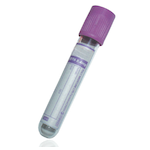Suitable Specimen Types
- EDTA Whole Blood
Specimen Transport
First class postSample Processing in Laboratory
See notes belowTurnaround Time
2-3 weeksSample Stability
See notes belowCholinesterase
General Information
There are normally 2 cholinesterase enzymes, one found predominantly in erythroocytes and nervous tissue (acetylcholinesterase). The other, found in plasma (cholinesterase or pseudocholinesterase), is synthesised mainly in the liver.
Measurements of cholinesterase are used:
- As an indicator of possible insecticide poisoning
- For the detection of patients with atypical forms of the enzyme who are at risk of prolonged responses to certain muscle relaxants used in surgical procedures
- As a test of liver function
Suxamethonium and mivacurium, drugs used in surgery as muscle relaxants, are hydrolysed by cholinesterase. The administration of these drugs to patients with a low cholinesterase activity (usually due to an enzyme variant) is often followed by prolonged periods of apnoea. The abnormal cholinesterase variants may be classified by measuring the percentage inhibition of the enzyme activity by dibucaine or by fluoride. A low dibucaine number with a very low activity is usually due to the presence of an abnormal gene. All affected individuals should carry a warning card and identification of affected relatives should be done.
Organic phosphorus compounds which inhibit cholinesterase activity include insecticides such as:
- Parathion
- Sarin
- Tetraethyl Pyrophosphate
If sufficient amounts of these compounds are absorbed via inhalation to inactivate all the acetylcholinesterase of the nervous tissue, death will result. Both serum and erythroocyte cholinesterases are inhibited, but the activity of the serum enzyme falls more rapidly than the erythroocyte form.
Cholinesterase should not be used routinely for the assessment of liver function.
Use the code CHOLIN for plasma/pseudo/butyrylcholinesterase (BChE) activity and phenotype. Use the code CHOLG for genotype studies.Patient Preparation
Patient should have recovered from anaesthesia and immediate post-operative period
Notes
SPECIMEN REQUIREMENTS: Preferred sample type is whole blood EDTA - do not spin or freeze. Store at 4ºC. This allows referral lab to do both phenotype and genotype analysis if required.
If EDTA has been spun, separated plasma and the packed cells can be sent to referral lab. Store at 4ºC before sending. The packed cells MUST NOT be frozen. If the specimen has been separated in house, this must be noted on referral request form.
Lithium heparin plasma or serum samples are also suitable for analysis in the absence of EDTA whole blood - centrifuge and store at 4 ºC. Refer request to Duty Biochemist (Bleep 2506)
Blood collected into citrate or fluoride-oxalate is unsuitable for cholinesterase analysis.
Reference Range
Provided by Reference Laboratory
Specifications
- EQA Status: No details
